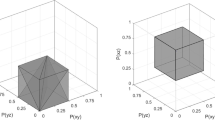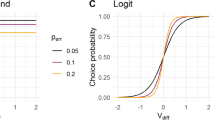Abstract
Choices between gambles show systematic violations of stochastic dominance. For example, most people choose ($6, .05; $91, .03; $99, .92) over ($6, .02; $8, .03; $99, .95), violating dominance. Choices also violate two cumulative independence conditions: (1) If S = (z, r; x, p; y, q) ≻ R = (z, r; x′, p; y′, q) then S‴ = (x′, r; y, p + q) ≻ R″ = (x′, r + p; y′, q). (2) If S′ = (x, p; y, q; z′, r) ≺ R′ = (x′, p; y′, q; z′, r) then S‴ = (x, p + q; y′, r) ≺ R‴ = (x′, p; y′, q + r), where 0 < z < x′ < x < y < y < y′ < z′.
Violations contradict any utility theory satisfying transivity, outcome monotonicity, coalescing, and comonotonic independence. Because rank-and sign-dependent utility theories, including cumulative prospect theory (CPT), satisfy these properties, they cannot explain these results.
However, the configural weight model of Birnbaum and McIntosh (1996) predicted the observed violations of stochastic dominance, cumulative independence, and branch independence. This model assumes the utility of a gamble is a weighted average of outcomes\' utilities, where each configural weight is a function of the rank order of the outcome\'s value among distinct values and that outcome\'s probability. The configural weight, TAX model with the same number of parameters as CPT fit the data of most individuals better than the model of CPT.
Similar content being viewed by others
References
Birnbaum, M.H. (1973). Morality judgment: Test of an averaging model with differential weights. Journal of Experimental Psychology 99, 395–399.
Birnbaum, M.H. (1974). The nonadditivity of personality impressions. Journal of Experimental Psychology, 102, 543–561.
Birnbaum, M.H. (1992). Violations of monotonicity and contextual effects in choice–based certainty equivalents. Psychological Science, 3, 310–314.
Birnbaum, M.H. (1997). Violations of monotonicity in judgment and decision making. In A.A.J. Marley (Eds.), Choice, decision and measurement: Essays in honor of R. Duncan Luce (pp.73–100). Mahwah, NJ: Erlbaum.
Birnbaum, M.H. (in press). Paradoxes of Allais, stochastic dominance, and decision weights. In J.C. Shanteau, Mellers, B.A., & Schum, D. (Eds.), Decision science and technology: Reflections on the contributions of Ward Edwards. Norwell, MA: Kluwer Academic Publishers.
Birnbaum, M.H., & Beeghley, D. (1997). Violations of branch independence in judgments of the value of gambles. Psychological Science, 8, 87–94.
Birnbaum, M.H. & Chavez, A. (1997). Tests of theories of decision making: Violations of branch independence and distribution independence. Organizational Behavior and Human Decision Processes, 71, 161–194.
Birnbaum, M.H., Coffey, G., Mellers, B.A., & Weiss, R. (1992). Utility measurement: Configural–weight theory and the judge's point of view. Journal of Experimental Psychology: Human Perception and Performance, 18, 331–346.
Birnbaum, M.H. & McIntosh, W.R. (1996). Violations of branch independence in choices between gambles. Organizational Behavior and Human Decision Processes, 67, 91–110.
Birnbaum, M.H., Patton, J.N., & Lott, M.K. (in press). Evidence against rank–dependent utility theories: Violations of cumulative independence, interval independence, stochastic dominance, and transitivity. Organizational Behavior and Human Decision Processes, 74, 000–000.
Birnaum, M.H., & Stegner, S.E. (1979). Source credibility in social judgment: Bias, expertise, and the judge's point of view. Journal of Personality and Social Psychology, 37, 48–74.
Birnbaum, M.H., & Sutton, S.E. (1992). Scale convergence and utility measurement. Organizational Behavior and Human Decision Processes, 52, 183–215.
Birnbaum, M.H., Thompson, L.A., & Bean, D.J. (1997). Testing interval independence versus configural weighting using judgments of strength of preference. Journal of Experimental Psychology: Human Perception and Performance, 23, 939–947.
Birnbaum, M.H., & Veira, R. (1998). Configural weighting in judgments of two–and four–outcome gambles. Journal of Experimental Psychology: Human Perception and Performance, 24, 216–226.
Birnbaum, M.H., & Yeary, S. (1997). Tests of cumulative independence, coalescing, and stochastic dominance in judgments of buying and selling prices of gambles. Working paper.
Birnbaum, M.H. & Zimmermann, J.M. (1998). Buying and selling prices of investments: Configural weight model of interactions predicts violations of joint independence. Organizational Behavior and Human Decision Processes, 74, 145–187.
Chandler, J.P. (1969). STEPIT: Finds local minima of a smooth function of several parameters (CPA 312). Behavioral Science, 14, 81–82.
Edwards, W. (1954). The theory of decision making. Psychological Bulletin, 51, 380–417.
Humphrey, S.J. (1995). Regret aversion or event–splitting effects? More evidence under risk and uncertainty. Journal of Risk and Uncertainty, 11, 263–274.
Karmarkar, U.S. (1978). Subjectively weighted utility: A descriptive extension of the expected utility model. Organizational Behavior and Human Performance, 21, 61–72.
Kahneman, D., Knetsch, J.L., & Thaler, R.H. (1991). Experimental tests of the endowment effect and the coarse theorem. In R.H. Thaler (Eds.), Quasi rational economics (pp. 167–188.). New York: Russel Sage Foundation.
Kahneman, D., & Tversky, A. (1979). Prospect theory: An analysis of decision under risk. Econometrica, 47, 263–291.
Lattimore, P.K., Baker, J.R., & Witte, A.D. (1992). The influence of probability on risky choice. Journal of Economic Behavior and Organization, 17, 377–400.
Leland, J.W. (1994). Generalized similarity judgments: An alternative explanation for choice anomalies. Journal of Risk and Uncertainty, 9, 151–172.
Lopes, L. (1990). Re–modeling risk aversion: A comparison of Bernoullian and rank dependent value approaches. In G.M. v. Furstenberg (Eds.), Acting under uncertainty (pp. 267–299). Boston: Kluwer.
Luce, R.D. (1988). Rank–dependent, subjective expected–utility representations. Journal of Risk and Uncertainty, 1, 305–332.
Luce, R.D. (1992). Where does subjective expected utility fail descriptively? Journal of Risk and Uncertainty, 5, 5–27.
Luce, R.D. (1996). When four distinct ways to measure utility are the same. Journal of Mathematical Psychology, 40, 297–317.
Luce, R.D. (submitted). Coalescing, event commutatively, and theories of utility. Submitted for publication, 00, 000–000.
Luce, R.D., & Fishburn, P.C. (1991). Rank–and sign–dependent linear utility models for finite first order gambles. Journal of Risk and Uncertainty, 4, 29–59.
Luce, R.D., & Fishburn, P.C. (1995). A note on deriving rank–dependent utility using additive joint receipts. Journal of Risk and Uncertainty, 11, 5–16.
Luce, R.D., & von Winterfeldt, D. (1994). What common ground exists for descriptive, prescriptive, and normative utility theories? Management Science, 40(2), 263–279.
Mellers, B.A., Weiss, R., & Birnbaum, M.H. (1992). Violations of dominance in pricing judgments. Journal of Risk and Uncertainty, 5, 73–90.
Quiggin, J. (1982). A theory of anticipated utility. Journal of Economic Behavior and Organization, 3, 324–345.
Quiggin, J. (1985). Subjective utility, anticipated utility, and the Allais paradox. Organizational Behavior and Human Decision Processes, 35, 94–101.
Savage, L.J. (1954). Historical and critical comments on utility. In L.J. Savage (Eds.), The foundations of statistics (pp. 91–104). New York: Wiley.
Starmer, C., & Sugden, R. (1993). Testing for juxtaposition and event–splitting effects. Journal of Risk and Uncertainty, 6, 235–254.
Stevenson, M.K., Busemeyer, J.R., & Naylor, J.C. (1991). Judgment and decision–making theory. In M. Dunnette & L.M. Hough (Eds.), New handbook of industrial–organizational psychology (pp. 283–374). Palo Alto, CA: Consulting Psychologist Press.
Tversky, A., & Kahneman, D. (1986). Rational choice and the framing of decisions. Journal of Business, 59, S251–S278.
Tversky, A., & Kahneman, D. (1992). Advances in prospect theory: Cumulative representation of uncertainty. Journal of Risk and Uncertainty, 5, 297–323.
Tversky, A., & Wakker, P. (1995). Risk attitudes and decision weights. Econometrica, 63, 1255–1280.
Viscusi, K.W. (1989). Prospective reference theory: Toward an explanation of the paradoxes. Journal of Risk and Uncertainty, 2, 235–264.
Wakker, P. (1996). The sure–thing principle and the comonotonic sure–thing principle: An axiomatic analysis. Journal of Mathematical Economics, 25, 213–227.
Wakker, P., Erev, I., & Weber, E.U. (1994). Comonotonic independence: The critical test between classical and rank–dependent utility theories. Journal of Risk and Uncertainty, 9, 195–230.
Wakker, P., & Tversky, A. (1993). An axiomatization of cumulative prospect theory. Journal of Risk and Uncertainty, 7, 147–176.
Weber, E.U., & Kirsner, B. (1997). Reasons for rank–dependent utility evaluation. Journal of Risk and Uncertainty, 14, 41–61.
Wu, G. (1994). An empirical test of ordinal independence. Journal of Risk and Uncertainty, 9, 39–60.
Wu, G., & Gonzalez, R. (1996). Curvature of the probability weighting function. Management Science, 42, 1676–1690.
Author information
Authors and Affiliations
Rights and permissions
About this article
Cite this article
Birnbaum, M.H., Navarrete, J.B. Testing Descriptive Utility Theories: Violations of Stochastic Dominance and Cumulative Independence. Journal of Risk and Uncertainty 17, 49–79 (1998). https://doi.org/10.1023/A:1007739200913
Issue Date:
DOI: https://doi.org/10.1023/A:1007739200913




